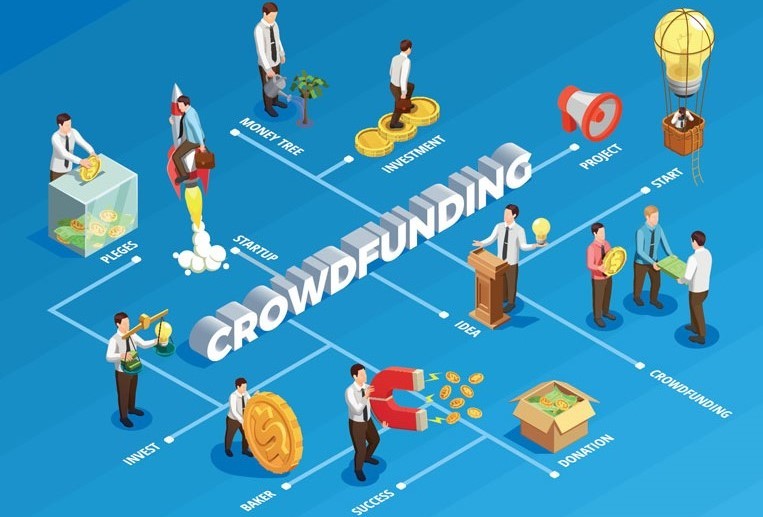What is crowdfunding and how does it work?
22 Jan 2021

How did quirky business ideas such as Bang-a-Salt insect killers, Crystal Bacon sculptures, and the Fat Iron get off the ground? The answer is crowdfunding.
Crowdfunding raises money for a business project or cause from many people rather than a few traditional lenders, usually via the internet. It had a quirky birth when fans of rock band Marillion, with their lead singer called Fish, launched the first campaign in 1997. The band could not afford to play in America, so fans raised $60,000 online to fund the tour.
But crowdfunding is not just a hotbed for innovation and weirdness. It has become a lifeline for entrepreneurs looking for a relatively quick and efficient funding channel. This has led to the global crowdfunding market growing to $10 billion in 2018 and a projected $30 billion by 2025, according to researchandmarkets.com.
This article covers
How does crowdfunding work?
To start crowdfunding, companies typically set up a profile of the project they want to fund on a platform such as Crowdcube, Seedrs or Kickstarter - see a fuller list at the UK Crowdfunding Association.
You can then use digital, social and traditional communication channels to start raising interest and funds.
Your platform listing should generally summarise and pitch the project, and say:
• how much you aim to raise
• the amount raised so far, and number of investors
• what investors will receive in return
• how you will use the money
• the funding deadline.
Often, the investment can only go ahead if you raise the full amount in time.
Crowdfunding types
Donation and reward crowdfunding
This is non-profit crowdfunding, where people invest because they believe in a cause such as animal conservation. You can simply accept donations or offer rewards such as album cover name checks, gifts, or tickets to an event.
Debt crowdfunding
Debt crowdfunding is comparable to a traditional loan in that lenders receive their money back with interest. But it bypasses large lenders such as banks.
Equity crowdfunding
In this model, you exchange funding for shares in your company or venture.
Previously, raising capital from the public meant issuing a prospectus and going public - something only established organisations could do. But many countries now permit companies to do this through crowdfunding.
Advantages of crowdfunding for companies
For early-stage companies, traditional lenders’ demands can be onerous. Online crowdfunding can be faster and more efficient and accessible - some companies with great ideas have raised the money they need in a few days. However, you should not underestimate the time and resources it can involve.
Crowdfunding can bring you rapid attention as your project gains exposure to many people through the platform and your media campaign.
Pitching your project online helps you get an idea of its feasibility, as people will only fund you if they believe in its potential.
Many heads are better than one. Crowdfunding enables you to field questions, feedback, and ideas from many people. This can create a form of mass brainstorming, helping you hone your pitch and business model. Your company’s next great idea could even come from a crowdfunding investor.
A strong campaign will help you build social proof and validation through the interest and support you generate. Early adopters can become loyal brand advocates, making others more likely to follow.
This could also bring pre-orders or media attention that is invaluable as you grow and pitch to other investors. It can even help you grow beyond where you might have done with traditional finance.
As mentioned, crowdfunding has proved invaluable for many niche or innovative ideas that might not otherwise find investors. You do not have to meet the potentially strict or narrow criteria of banks, you simply have to persuade investors online to believe in your project.
Disadvantages and risks of crowdfunding
Fewer than a quarter of all crowdfunding projects are successful.
Experienced crowdfunders say successful projects must be visible, finite and easy to understand. You may need to create a lot of awareness and marketing activity around your campaign to generate enough investor interest. A company with a limited network and social media presence, or a complicated product, will find it harder to crowdfund successfully.
The danger is that you spend time applying to the platforms and raising awareness but fail to raise the funding target, which usually means you get nothing. Such a failure could harm your reputation, making subsequent funding efforts harder.
You must apply the same financial planning and rigour as you would to any other funding process. For example, with equity crowdfunding, if you miscalculate the investment level and potential returns, you risk giving away too much of your business, or not enough and therefore missing an opportunity.
One final risk is that displaying too many details of your idea publicly risks others copying it.
Conclusion
Crowdsourcing has grown into an exciting way for entrepreneurs and early-stage companies to find capital and early adopters, validate their business model, and get the exposure they need to grow.
Providing you understand the concept and commit to it, it could fast-track funding and become a launchpad to greater things.
The content on our site is provided for general information only. Obtain specialist advice before taking, or refraining from, any action on the basis of the content on our site.


